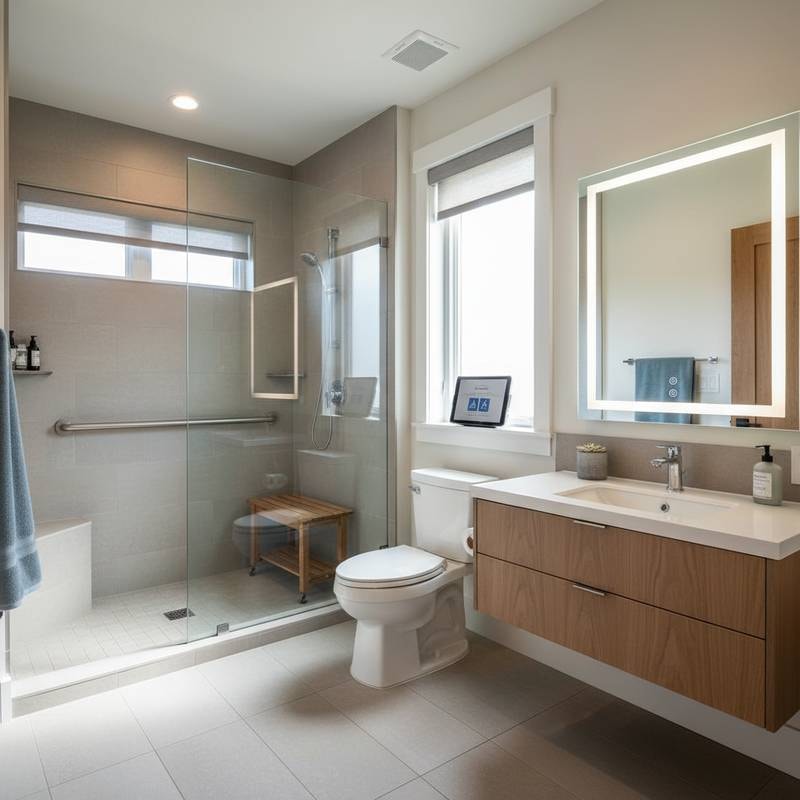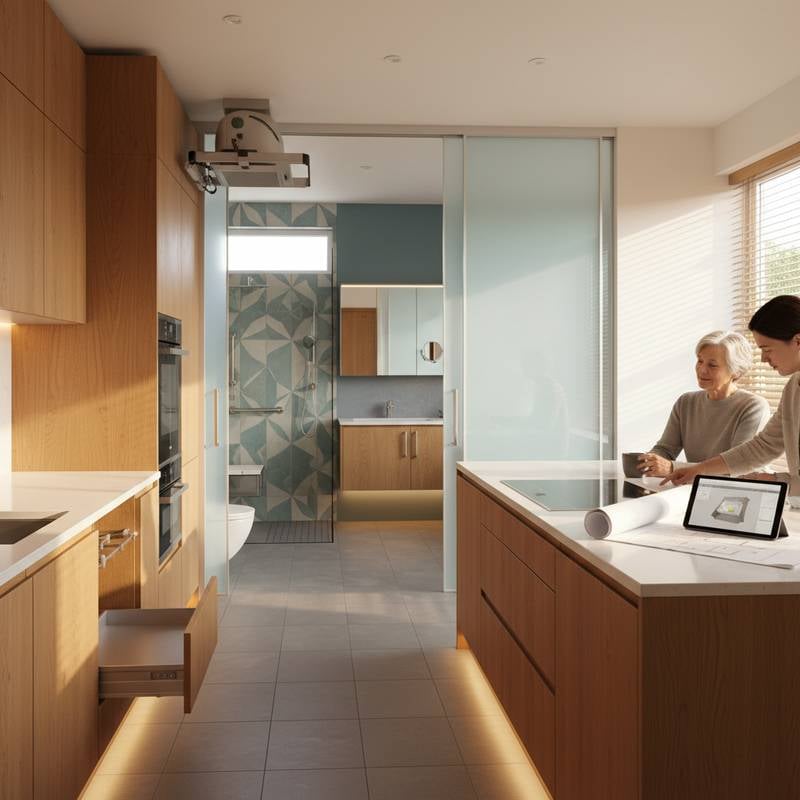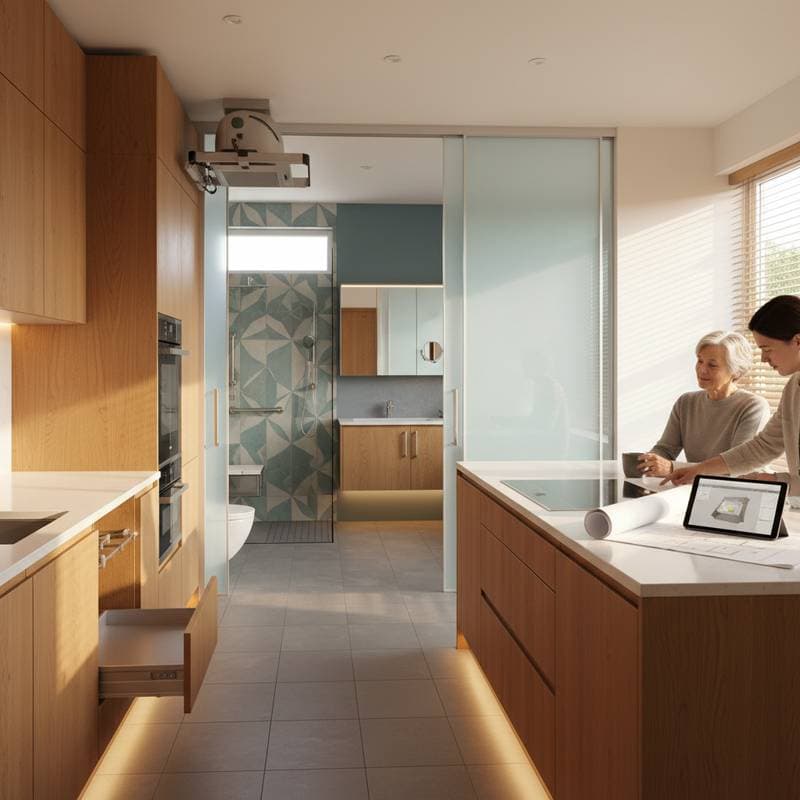2025 Costs for Aging-in-Place Home Remodels: A Comprehensive Guide
Homeowners increasingly choose aging-in-place remodels to adapt their living spaces for long-term independence. These modifications enhance safety and accessibility while preserving property value and minimizing future expenses. This guide details current costs, essential design elements, and practical steps to transform a home into a supportive environment.
Understanding Aging-in-Place Remodeling
Aging-in-place remodeling adapts homes to accommodate varying mobility needs through universal design principles. This approach integrates accessibility features seamlessly into everyday spaces, such as lever handles, zero-threshold entries, and ample lighting, without compromising aesthetic appeal. The goal is to create an environment that supports residents as they age, promoting comfort and autonomy.
Investing in these updates proves cost-effective compared to alternatives like assisted living. National data indicates that comprehensive accessibility renovations often total less than the annual cost of facility care. Homeowners gain both immediate usability and long-term financial benefits from such proactive changes.
Bathroom Modifications for Safety and Accessibility
Why It Matters: Bathrooms present high risks due to wet surfaces, uneven floors, and confined spaces, making modifications essential for preventing falls and ensuring ease of use.
Typical Costs:
- Walk-in or curbless showers: $5,000 to $12,000
- Grab bars and reinforced walls: $500 to $2,000
- Raised toilets or comfort-height fixtures: $800 to $3,500
- Non-slip flooring and waterproofing: $2,500 to $7,000
DIY vs. Pro: Installing grab bars or adding bath mats qualifies as straightforward DIY tasks with proper tools. Complex elements like shower conversions or plumbing adjustments demand professional expertise to comply with safety codes.
Tips: Opt for fold-down benches in showers, install anti-scald devices on faucets, and select contrasting colors for fixtures to improve visibility. These changes reduce injury risks while maintaining a spa-like atmosphere.
Kitchen Modifications for Accessibility
Why It Matters: Kitchens involve multiple hazards, including hot surfaces and reaching requirements, which complicate tasks for those with reduced mobility.
Typical Costs:
- Lowered or adjustable countertops: $3,000 to $8,000
- Pull-out shelves and lazy Susans: $500 to $2,500
- Side-opening ovens or compact dishwashers: $1,000 to $4,500
- Non-slip flooring and task lighting: $2,000 to $6,000
DIY vs. Pro: Simple updates like cabinet organizers or under-cabinet lights suit DIY efforts. Height adjustments to counters or specialized appliances necessitate professional installation for structural integrity.
Tips: Position appliances at waist level for convenience, incorporate touchless faucets, and use matte finishes to minimize glare. These enhancements streamline daily routines and enhance overall kitchen functionality.
Bedroom and Living Area Adjustments
Why It Matters: Establishing first-floor living spaces eliminates stair-related dangers and supports independent movement throughout the home.
Typical Costs:
- Converting a space into a primary bedroom suite: $5,000 to $15,000
- Stairlift or elevator installation: $3,000 to $7,500
- Widened doorways and threshold ramps: $1,000 to $4,000
- Ambient lighting and mobility-friendly flooring: $1,500 to $5,000
DIY vs. Pro: Rearranging furniture or adding cordless blinds works well as DIY projects. Alterations like doorway expansions or stair modifications require licensed professionals to handle permits and engineering.
Tips: Select adjustable bed frames, install outlets at multiple heights, and choose wide pathways for wheelchair navigation. These adjustments foster a restful and navigable living environment.
The Value and Return on Investment of Universal Design
Aging-in-place features extend beyond personal use by increasing a home's market appeal. Properties with inclusive designs draw diverse buyers, including multigenerational families. Studies from remodeling associations show that investments in accessible bathrooms and entryways recoup 60 to 80 percent of costs upon sale, varying by location and execution.
Elements like single-lever faucets, wide corridors, and smooth transitions integrate effortlessly into contemporary interiors. Such designs accommodate not only aging residents but also visitors with temporary mobility challenges, adding broad versatility to the home.
When to Hire a Professional
Homeowners manage minor tasks, such as mounting grab bars or configuring smart thermostats, using basic supplies. Professionals become necessary for:
- Rewiring electrical systems or updating plumbing
- Removing walls or installing exterior ramps
- Applying waterproof membranes in wet areas
- Modifying load-bearing structures or stairs
- Navigating local permits and inspections
Select contractors with expertise in universal design or certifications from organizations like the National Association of Home Builders. Request client testimonials, confirm licensing and insurance, and insist on itemized estimates. Qualified experts ensure compliance with accessibility guidelines and deliver durable results.
Common Questions About Aging-in-Place Remodels
How long does an aging-in-place remodel take? Minor enhancements finish in days, while extensive projects span weeks, influenced by project scale and supply availability.
Do these upgrades make my home look institutional? Contemporary materials, soft illumination, and stylish integrations maintain a welcoming, personalized appearance.
Is it better to remodel or relocate to a single-level home? Remodeling suits situations where community ties and current layouts align with needs, offering lower costs and minimal upheaval.
What flooring options best support accessibility? Choices like luxury vinyl planks, low-profile carpets, and textured tiles deliver traction and simplicity in cleaning.
Does widening doors compromise structural integrity? Non-load-bearing walls pose no issue; experts assess and reinforce as needed for safety.
Sustaining Accessibility Features Over Time
Regular upkeep preserves the effectiveness of aging-in-place investments. Schedule yearly checks for secure grab bars, clear ramps, and functional lights. Refresh slip-resistant surfaces promptly to avoid wear-related hazards, and upgrade connected devices to sustain performance.
These modifications secure not just future readiness but present-day enjoyment. Through strategic planning, balanced budgets, and skilled collaboration, a home evolves into a enduring haven of independence and ease.











